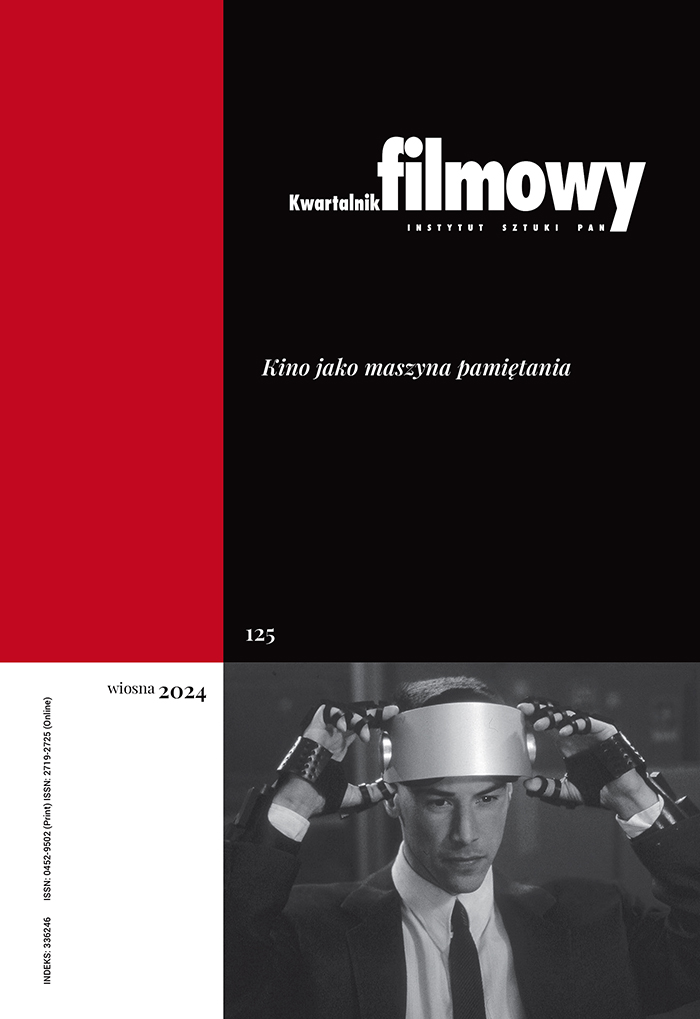“The Night Journey”: Bill Viola’s “Game” in Search for New Spaces
Abstract
In the introduction, Pitrus notes that video art always defined space in a slightly different way than it is defined in cinema. This was a result of the artists’ intentions, wishing to highlight the distinctiveness of the means of expression of new medium, and objective factors in video art: unlike in the cinema the viewer saw not only the movie frame, but also the machine. Additionally, film, in the traditional sense, was edited linearly, as a sequence of shots, while video art was an opportunity for the use of the strategy of mise-en-page. The ambivalence in terms of use and understanding of space in video art is also present in the work of Bill Viola. Pitrus analyses a selection of Viola’s works and immersive video installations, but he concentrates on the interactive project The Night Journey, in which Viola, for the first time, referred to the technology used in video games. The project uses technology platform created for games, and mechanics typical for this type of entertainment. Pitrus considers the project, particularly concentrating on navigation and the possibility of interaction. He notices that The Night Journey focuses on immersion and deconstructs the mechanics of classic entertainment.
Keywords:
Bill Viola, video art, mise-en-page, spaceReferences
Bazin André, Film i rzeczywistość, tłum. B. Michałek, WaiF, Warszawa 1963, s. 59.
Google Scholar
Bruce Elder R., The Films of Stan Brakhage in the American Tradition of Ezra Pound, Gertrude Stein and Charles Olson, Wilfrid Laurier University Press, Waterloo 1998.
Google Scholar
Coomaraswamy Ananda K., Symbols, w: Coomaraswamy Ananda K., What is Civilisation?, Lindisfarne Press, Great Barrington 1989, s. 125-126.
Google Scholar
Heath Stephen, Narrative Space, „Screen” 1976, nr 3, s. 68-112.
DOI: https://doi.org/10.1093/screen/17.3.68
Google Scholar
Heeter Carrie, Being There: The Subjective Experience of Presence, „Presence: Teleoperators and Virtual Environments 1” 1992, nr 2, s. 2.
DOI: https://doi.org/10.1162/pres.1992.1.2.262
Google Scholar
Kamieńska Anna, Przekładając „Naśladowania...”, w: T. A. Kempis, O naśladowaniu Chrystusa, PAX, Warszawa 1980, s. 258.
Google Scholar
Kłodkowski Piotr, Homo mysticus hinduizmu i islamu. Mistyczny ruch bhakti i sufizmu, Wydawnictwo Akademickie Dialog, Warszawa 1998.
Google Scholar
Lipkin Steve, Technologia jako ontologia, w: Pejzaże audiowizualne. Telewizja, wideo, komputer, tłum. T. Kalaga, red. A. Gwóźdź, Universitas, Kraków 1997, s. 316.
Google Scholar
Nitsche Michael, Video Game Spaces. Image, Play and Structure In 3D Worlds, The MIT Press, Cambridge – London 2008, s. 93.
DOI: https://doi.org/10.7551/mitpress/9780262141017.001.0001
Google Scholar
Oudart Jean-Pierre, Notes pour une théorie de la representation, „Cahiers du Cinéma” 1971, nr 229 i 230.
Google Scholar
Plotyn, Enneady, tłum A. Krokiewicz, PWN, Warszawa 1959.
Google Scholar
Sufism, Music and Society in Turkey and the Middle East, red. A. Hammarlund, T. Olsson, E. Özdalga, Curzon, Richmond 1999.
Google Scholar
Suzuki Daisetz Teitaro, Wprowadzenie do buddyzmu zen, tłum. M. i A. Grabowscy, Rebis, Warszawa 2004.
Google Scholar
Św. Jan od Krzyża, Droga na Górę Karmel, tłum. B. Smyrak OCD, Wydawnictwo Karmelitów Bosych, http://www.karmel.pl/klasyka/gora/index.php.
Google Scholar
Whitehead Alfred N., Science and the Modern World, Cambridge University Press, Cambridge 1926, s. 90.
Google Scholar
Viola Bill, Reasons for Knocking at an Empty House, The MIT Press, Cambridge 1995, s. 161.
Google Scholar
Authors
Andrzej Pitruskwartalnik.filmowy@ispan.pl
Jagiellonian University Poland
Pracownik naukowy Instytutu Sztuk Audiowizualnych UJ. Autor książek Nam niebo pozwoli. O filmowej i telewizyjnej twórczości Todda Haynesa (2004), Filmowcy i kiniarze (2004), Dotykając lustra. Melodramaty Douglasa Sirka (2006). Znawca problematyki kina niezależnego.
Statistics
Abstract views: 625PDF downloads: 146
License
Copyright (c) 2010 Andrzej Pitrus

This work is licensed under a Creative Commons Attribution 4.0 International License.
The author grants the publisher a royalty-free non-exclusive licence (CC BY 4.0) to use the article in Kwartalnik Filmowy, retains full copyright, and agrees to identify the work as first having been published in Kwartalnik Filmowy should it be published or used again (download licence agreement). The journal is published under the CC BY 4.0 licence. By submitting an article, the author agrees to make it available under this licence.
In issues from 105-106 (2019) to 119 (2022) all articles were published under the CC BY-NC-ND 4.0 licence. During this period the authors granted a royalty-free non-exclusive licence (CC BY-ND 4.0) to use their article in „Kwartalnik Filmowy”, retained full copyright, and agreed to identify the work as first having been published in our journal should it be published or used again.
Most read articles by the same author(s)
- Andrzej Pitrus, Mum Naked: The Naked Body of a Mother in Contemporary Visual Art , Kwartalnik Filmowy: No. 83-84 (2013): Body in Film
- Andrzej Pitrus, Chris Marker’s Travels in Time: The Curious Fate of “La Jetée” , Kwartalnik Filmowy: No. 89-90 (2015): Redefinitions of the Classics
- Andrzej Pitrus, An Essay Devoid of a Title, About a Journey Home, Which Home Does Not Exist and Perhaps Never Will Be, or to a Home Which Once Belonged to Entirely Someone Else , Kwartalnik Filmowy: No. 107 (2019): Journey, (E)migration, Pilgrimage
- Andrzej Pitrus, An Essay Devoid of a Title, About a Country that Turned its Back on its Children , Kwartalnik Filmowy: No. 105-106 (2019): Cinema and Political Transformation
- Andrzej Pitrus, It is Us Who Invented Time: “Ocean Without a Shore” and “Transfigurations” by Bill Viola , Kwartalnik Filmowy: No. 86 (2014): Dimensions of Time
- Andrzej Pitrus, The Closed Spaces of Bill Viola , Kwartalnik Filmowy: No. 79 (2012): Interiors: On Cinematic Enclosed Space
- Andrzej Pitrus, Cinema Without Secrets , Kwartalnik Filmowy: No. 75-76 (2011): Faces of Reality
- Andrzej Pitrus, Reckoning With German Cinema , Kwartalnik Filmowy: No. 80 (2012): Film at the Meeting Point of Cultures
- Andrzej Pitrus, Known and Unknown Forms , Kwartalnik Filmowy: No. 87-88 (2014): Film and Theatre
- Andrzej Pitrus, Eye to Eye With the Animal: “I Do Not Know What It Is I Am Like” and Intercultural Negotiations of Bill Viola , Kwartalnik Filmowy: No. 80 (2012): Film at the Meeting Point of Cultures











